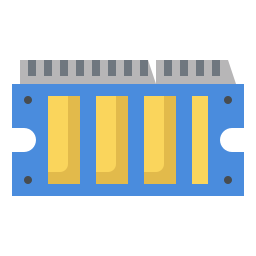
RAM (Memory) in Computer Hardware Components
Random Access Memory, commonly referred to as RAM, is one of the most essential hardware components in a computer system. It plays a crucial role in determining the speed, performance, and multitasking capability of a computer. RAM is considered a type of volatile memory, meaning it only stores data temporarily while the system is powered on. Once the computer is turned off, all data stored in RAM is lost. Unlike storage devices such as hard drives or SSDs, RAM is designed to provide rapid access to data that the CPU needs immediately, enhancing the overall performance and responsiveness of the system.
Functions and Applications of RAM in Computer Systems
Temporary Data Storage: RAM temporarily holds data that is actively being used or processed by the CPU. This includes operating system files, application data, and files currently being worked on by the user.
Enhancing System Speed: More RAM allows the system to run more applications simultaneously without slowing down. It reduces the need for the system to rely on slower storage devices for temporary data, thus improving speed and performance.
Efficient Multitasking: With sufficient RAM, users can switch between multiple applications without experiencing lag or performance issues. This is particularly important in environments where productivity and speed are essential, such as video editing, graphic design, and programming.
Supporting Operating System Functions: Operating systems require a certain amount of RAM to function smoothly. RAM helps manage background processes, system updates, and service applications that operate continuously.
Running Heavy Software: Applications such as computer-aided design (CAD) software, video editing tools, virtual machines, and 3D rendering programs require a significant amount of RAM to operate efficiently. Without enough memory, these programs may crash or run extremely slowly.
Gaming Performance: Modern video games rely heavily on RAM to load assets such as textures, maps, and character data quickly. A computer with more RAM can run games more smoothly and reduce loading times.
Browsing Experience: Web browsers today can consume a large portion of RAM, especially when multiple tabs are open or media content is being streamed. More RAM ensures a fluid and responsive browsing experience.
Cost and Availability of RAM
RAM is a physical hardware component that must be purchased separately or as part of a computer system. It is not a free or downloadable resource.
The cost of RAM depends on several factors, including:
Capacity: Higher capacity modules are more expensive. For example, a 32GB module will typically cost more than an 8GB module.
Speed: RAM speed, measured in MHz, also affects price. Faster RAM provides better performance but comes at a higher cost.
Type: There are various generations of RAM (such as DDR3, DDR4, DDR5), each with different price points. Newer generations offer better performance but are also more costly.
Brand and Quality: Trusted brands that offer warranties and better quality control tend to have higher prices.
Therefore, while the benefits of having more RAM are clear, it does come with a monetary cost. Users must balance their performance needs with their budget when choosing RAM.
Comparison with Other Hardware Components
Compared to a hard disk drive (HDD), RAM is much faster but cannot store data permanently. RAM is for immediate access, whereas an HDD is used for long-term storage.
Compared to a solid-state drive (SSD), RAM is still faster in data access but SSDs provide permanent storage. However, SSDs are catching up in speed and are commonly used in modern systems alongside RAM.
Unlike a CPU, which performs the actual computation and processing, RAM simply holds data temporarily for the CPU to access. Without RAM, the CPU cannot function efficiently as it would have to retrieve data directly from slower storage.
Compared to graphics memory (VRAM), which is specialized memory for handling visual and graphical data, standard RAM is used by the whole system. Both are important, especially in gaming and creative work, but they serve different purposes.
Conclusion
RAM is a vital hardware component that directly affects the speed, efficiency, and overall performance of a computer. Its primary role is to temporarily store data for quick access by the CPU, enabling smooth multitasking, faster program execution, and improved system responsiveness. While it is not free and must be purchased based on capacity and performance needs, investing in sufficient and quality RAM can significantly enhance the user experience. In comparison to other hardware components, RAM stands out for its speed and its role in immediate data access, making it a central part of any well-functioning computer system. Ultimately, choosing the right amount and type of RAM based on individual needs and system requirements is essential for optimal hardware performance.












